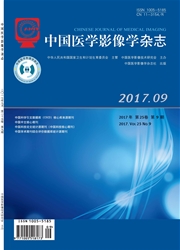

 中文摘要:
中文摘要:
目的探讨基于增强MRI纹理分析对区分非产褥期乳腺炎与非肿块样强化病灶乳腺癌的可行性,以期降低非产褥期乳腺炎患者误诊的风险。资料与方法回顾性分析42例非肿块样强化病灶乳腺癌和30例乳腺炎患者的增强MRI图像数据。手动勾画病灶以及正常组织感兴趣区,对每个ROI提取3234个纹理特征,通过稳定性筛查去除对感兴趣区选择敏感的特征,并使用遗传算法和线性判别分析最终提取10个纹理特征对非产褥期乳腺炎、非肿块样强化病灶乳腺癌及正常乳腺组织进行分类。结果使用这10个特征的线性判别分析分类器对三类组织分类的总体准确率为89.6%。其中,对炎-癌分类的敏感度和特异度分别达92.9%和90.0%,说明纹理分析可成功区分非产褥期乳腺炎与非肿块样强化病灶乳腺癌。结论纹理分析能够可靠地区分非产褥期乳腺炎、非肿块样强化病灶乳腺癌及正常乳腺组织,为临床诊断提供可靠的结果。
 英文摘要:
英文摘要:
Purpose To investigate the feasibility of texture analysis of breast contrast- enhanced magnetic resonance imaging in differentiating non-puerperal mastitis and breast carcinoma with non-mass-like enhancement in order to prevent misdiagnosis of non- puerperal mastitis. Materials and Methods In this retrospective study, the contrast- enhanced MRI images of 42 female patients of invasive ductal carcinoma with non-mass- like enhancement and 30 female patients of non-puerperal mastitis were analyzed. 3234 texture features were generated from manually selected region of interest (ROI) of normal breast tissue and breast lesions. By means of genetic algorithm and linear discriminative analysis, 10 texture features were selected based on their stability and accuracy in breast tissue classification. Results With these 10 features, the linear discriminative analysis classifiers had sensitivity of 92.9% and specificity of 90.0% in classifying two lesions, and accuracy of 89.6% in classifying all three types of tissue. The result showed that texture analysis successfully differentiate non-puerperal mastitis and breast carcinoma with non- mass-like enhancement. Conclusion Texture analysis demonstrates the ability of differentiating invasive ductal carcinoma with non-mass-like enhancement, non-puerperal mastitis and normal breast tissue, and provides reliable results for clinical diagnosis.
 同期刊论文项目
同期刊论文项目
 同项目期刊论文
同项目期刊论文
 期刊信息
期刊信息
